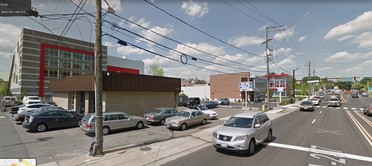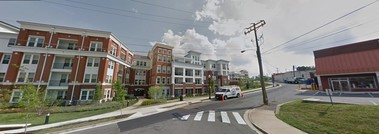Key Planning Elements Series: Part 4
Welcome to Part 4 of this newsletter series on Plan Langston Boulevard’s key planning elements. This newsletter is talking about BUILDING FORM. If you would like to take a deeper dive into all the public feedback received or read the full reports, go to the Documents webpage or click the links throughout this newsletter.
The Key Planning Elements are:
-
Land Use
-
Economic Vitality
- Housing
-
Building Form
-
Transportation, Connectivity, and Urban Design
-
Public Schools, Facilities, and Spaces
-
Historic and Cultural Resources
-
Sustainability and Resilience
Have you weighed in on the corridor-wide objectives or neighborhood improvements and benefits that are most important to you? There's a feedback form on the PLB webpage that will close on Friday, March 25.
Building Form
Goal: Transform Langston Boulevard and its neighborhoods into a walkable environment with context‐sensitive buildings
“We shape our buildings; thereafter they shape us.” Winston Churchill
In the past 100 years, building form has been influenced by the need to accommodate cars. Less emphasis has been placed on defining spaces for pedestrians and bicyclists, resulting in buildings and spaces that could be almost anywhere. The buildings we live and work in have an impact on our health and wellbeing. We should construct and manage them responsibly—using natural resources when possible, meeting energy goals, and contributing to effective stormwater management.
The placement of buildings—their scale, orientation, and aesthetics; how vehicles move and park around them; and their relationship to each other—becomes an integral part of land use discussions. Establishing guidance for building form can help development fit into context, ensuring it engages with streets and creates a transition in scale, height, and character appropriate for the corridor and surrounding neighborhoods. There is a wide array of building forms in the Plan Langston Boulevard study area, often defined by their parking configurations and requirements, which makes planning more difficult. Only certain parcels along Langston Boulevard are large enough to accommodate new development with appropriate building scale to meet mixed-use formats and contemporary building design for residential development, as well as building mass transitions, parking, and landscape buffers.
The Plan envisions transforming Langston Boulevard into a main street—bringing buildings closer to the street and moving parking to the rear of the site or underground to create welcoming spaces for people to walk and bike. The plan for Langston Boulevard will:
-
Encourage diverse building types and sizes
-
Develop guidelines for building form and design character that fit into neighborhood context
-
Focus areas for new building height levels:
-
at key nodes and intersections,
-
in areas accessible to bus routes or near Metro,
- on parcels with sufficient depth for appropriate transitions to the lower residential edges, and
- in places where other infrastructure, topography, or natural environment allow
- Define maximum building heights, minimum building setbacks, pervious area requirements, and areas where step downs in height or other transitions are needed
- Encourage ground floor uses that support the community with welcoming streets, pedestrian pathways, and trails
- Designate desired locations for parking access and loading/service bays
Incentivizing Community Improvements, High Performance Buildings, and Quality Architecture
Community benefits and improvements cannot be provided by the public sector alone. It will take collaboration between landowners and the County to share responsibilities and establish a mutually beneficial outcome.
Existing by-right development has not always been embraced by the community and has done little to meet Plan Langston Boulevard’s goals. Many parcels along the corridor are small, constrained, and frequently under individual ownership, making consolidation a challenge in the absence of development incentives. The County’s special exception process could achieve some improvements and benefits but has additional costs and an extensive public review process that can make it infeasible. In addition, smaller parcels mean some amenities and infrastructure improvements remain out of reach, which could result in less cohesive improvements from block to block.
We are working to guide and achieve predictable development along Langston Boulevard. Changes will allow additional building height if landowners provide greater community benefits and improvements than would be provided through by-right development. Height and density above by-right zoning levels can incentivize property owners to assemble parcels where needed and invest in high-performance development that benefits the community and meets Plan Langston Boulevard’s goals. Consolidation of properties fronting the corridor can, for example, establish a cohesive streetscape with underground utilities, separated pedestrian and bicycle facilities, and additional open space. It can also deliver committed affordable units (CAFs), enhanced stormwater management, higher architectural quality, and energy efficient buildings.
Results of By‐Right Development along Langston Boulevard

In East Falls
- No street trees
- Narrow sidewalks
- Buildings don’t relate to Langston Blvd. (i.e., parking is in front)
- Ground floor uses don’t encourage pedestrian activity
- Heavily auto oriented and many curb cuts along Langston Boulevard
- High percentage of impervious surfaces
|

Waverly Hills 20th Rd. & Glebe Rd.
- Above ground parking
- No accessible public open space
- Limited tree canopy along street
- Buildings front commercial service areas (trash and loading)
- Buildings along streets ‐ partially below grade to fit within the 40-foot height limit
- Buildings along single family areas are 5 stories and set back approximately 40 feet
- Very large block with limited walkability, connectivity, and vehicular circulation
|
2016 Visioning Study Report + Building Form
According to the 2016 Visioning Study Report, the plan for Langston Boulevard will strengthen neighborhoods by emphasizing unique architectural character, public space activities, and sensitive transitions.
The building form recommendations in the report include:
- Encouraging high level activity and visual appeal at the ground level
- Defining levels of intensity and specific building height parameters along corridor
- Smoothing height transitions between commercial and residential uses
- Promoting distinct neighborhood character through architectural design
- Maintaining existing residential character in residential sections along corridor, as well as areas adjacent to residential neighborhoods
- Creating ample sidewalks, high-quality landscaping, and intuitive wayfinding
- Considering alternative parking solutions (e.g., on-street, rear, shared, public, structured)
Existing Conditions Analysis Report + Building Form
The Existing Conditions Analysis Report evaluated building frontages along Langston Boulevard and other commercial corridors to understand how buildings interface with the street to create active use on the ground floor. It also analyzed the typical building types and design to understand the character and identity they create, as well as building heights and issues of transition created by height and mass, and activity or use.
The ECA showed that in the Langston Boulevard planning area:
- Cherrydale and East Falls Church buildings have more ground floor uses and windows that activate the street with parking behind or under buildings.
- Most commercial buildings along Langston Boulevard have fewer windows, less inviting doorways, large blank walls and parking lots in the front.
- Service and loading areas along the rear of commercial buildings are often adjacent to single-family homes.
- The Lee Harrison shopping center uses topography to reduce impacts of service areas to the adjoining neighborhood.
- There are many types of residential development in the planning area that range in size (1/4 to 7+ acres) and height (2 to 9+ stories).
- Single-family and townhouses are the most prominent residential typologies in the edge areas.
- High-rise buildings are only in a few locations, including Waverly Hills and North Highlands, and there are abrupt transitions between buildings of different scales (9 stories vs. 2 stories).
- In East Falls Church, recent mixed-use infill development relates well to adjacent neighborhoods by placing buildings of greater mass and height away from existing single-family homes. Townhomes are also used as a transitional building type.
- Nearly all buildings fronting Langston Boulevard are 4 stories or less.
- Most taller buildings are set back significantly from the street.
- Roughly half of the parcels along Langston Boulevard are less than 90-feet deep, which complicates redevelopment and makes achieving transitions in height more challenging.
Neighborhood Inspiration Report + Building Form
As reported in the Neighborhood Inspiration Report (see also the NIR Appendix), designing ground floor uses to make the street a welcoming environment was the most important design issue to address, while appropriate building height and mass transitions was the second most important across all neighborhoods. In 2050, the building forms in our neighborhoods will:
Area 1: Arlington East Falls Church
- Embrace and demonstrate diversity, from people to building types, and experiences
- Be more urban and vibrant
Area 2: John M. Langston, Yorktown, Tara Leeway Heights, Leeway Overlee
- Have buildings along Langston Boulevard that front the street with parking under, or at rear, with wider sidewalks and street trees
- Feel like a neighborhood, human scale and not like any other part of Arlington under redevelopment with tall mixed-use buildings that have no character
- Allow for some missing middle housing types, outside of Lee-Harrison intersection and Langston Boulevard, integrated into existing fabric that have a similar appearance, size, and height as existing 1930s homes with trees and green spaces
- Be inviting and feel charming
- Retain the look and feel of a small-scale community neighborhood—changes should blend in with surrounding single-family homes rather than stand out and should not replicate the Metro corridor
- Have a mix of height, scales, and architectural styles, like in Cleveland Park in DC (along Connecticut Avenue)
- Have buildings along Langston Boulevard that are built to the edge of the sidewalk and parking will be secondary
- Have buildings with front yards and setbacks
- Have strong connections to nature and integration of greenery and open space to create a feeling of openness between buildings and in the public realm
- Retain historic features, such as the architecture, built form, Sears Houses
- Incorporate new buildings designed to be compatible with historic homes and buildings in the neighborhood, with biophilic designs, and adhering to highest standards for energy efficiency and sustainability (solar panels and storage for resiliency)
Area 5: North Highlands + Lyon Village
- Have diversity of people and housing types
- Easily be able to walk or bike to commercial areas and neighborhood retail
- Be sustainable, dense, and have mixed-use
- Retain the quiet, low-density neighborhood in Lyon Village that is a convenient and enjoyable living space
Land Use Scenario Analysis + Building Form
Through several public feedback engagements with the Land Use Scenario Analysis, the community shared that they would only support additional height in some areas if it provided a combination of:
- Committed affordable units
- Decreased building footprint/paved surface
- Increased pervious areas and tree canopy
The key areas of concern regarding increased height are:
- Impact on schools and traffic
- Additional height not resulting in affordable housing and instead offering luxury units
- Confirming maximum height (i.e., that max heights in the Langston Boulevard plan will prevail over the Zoning Ordinance bonus height regulations)
The height preferences by area are:
- Area 1: specific heights not discussed
- Area 2: no greater than 2 or 3 stories
- Area 3: no greater than 7 stories (up to 8 in limited areas)
- Area 4: no greater than 7 stories
- Area 5: up to 4 to more than 15 stories
|